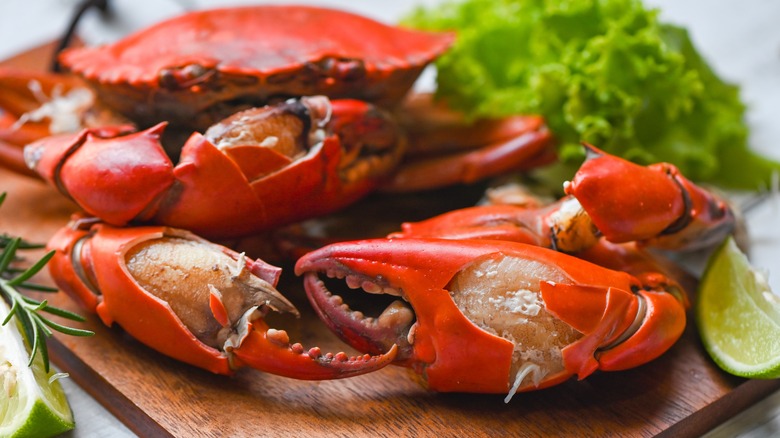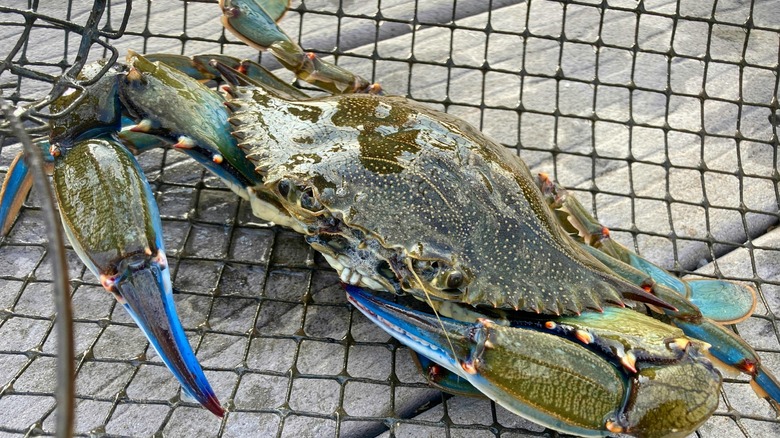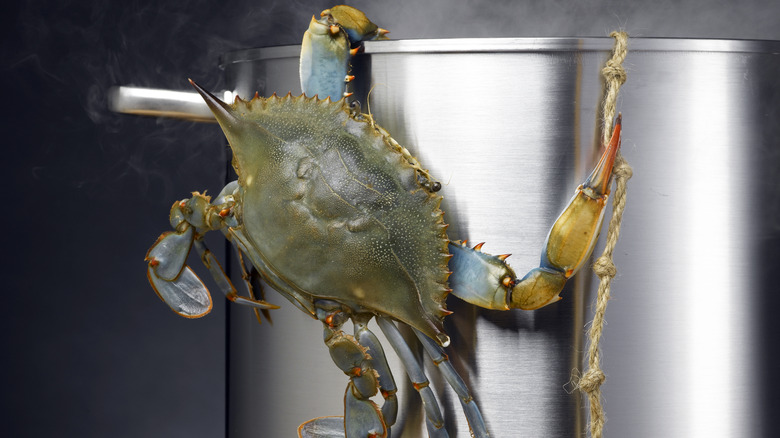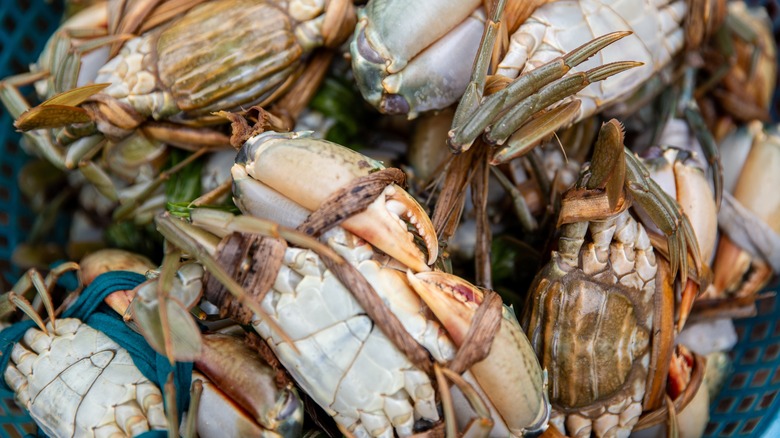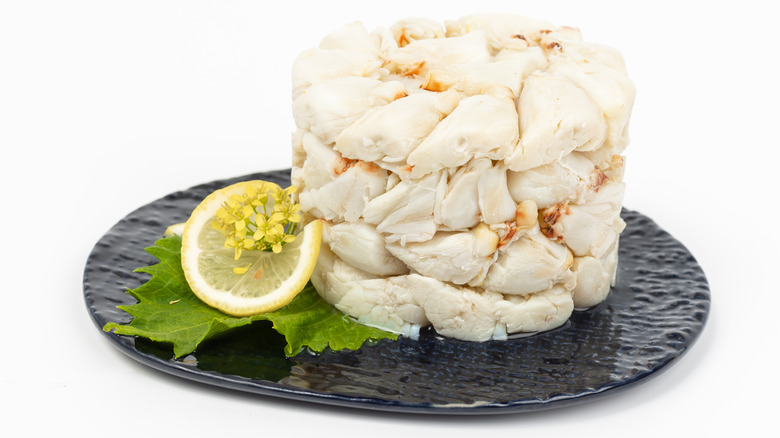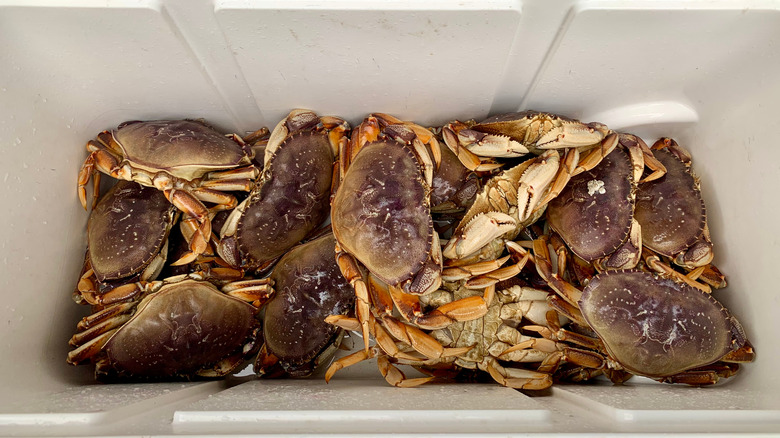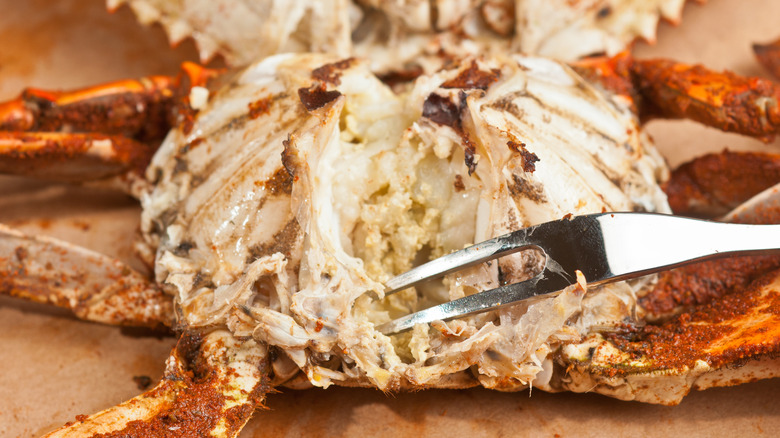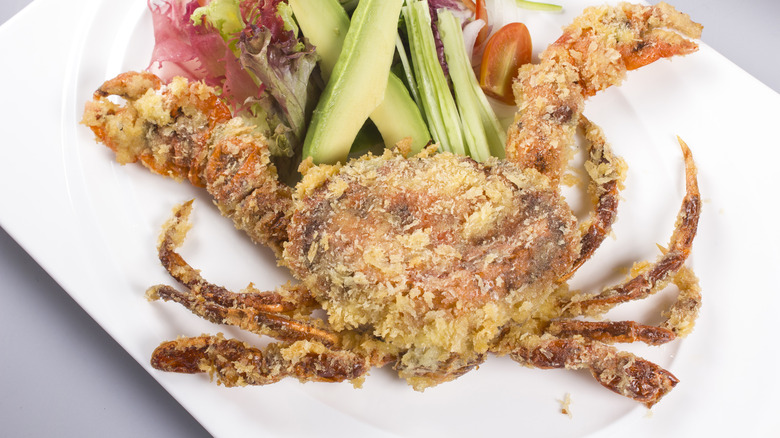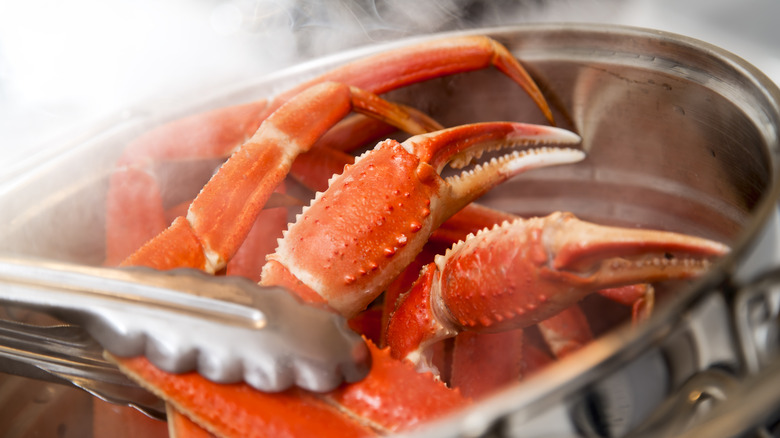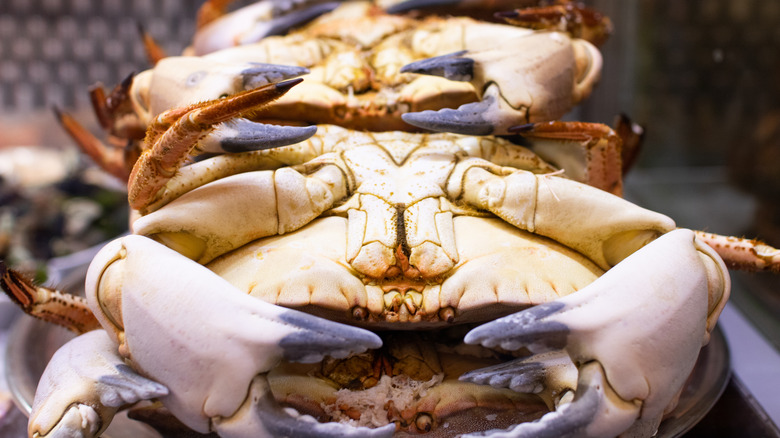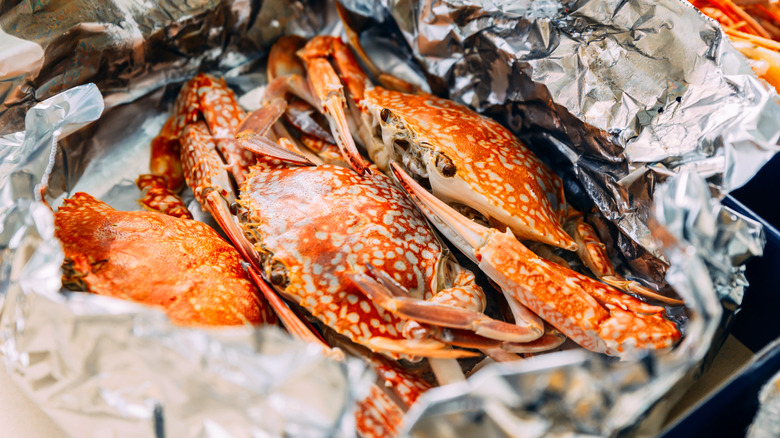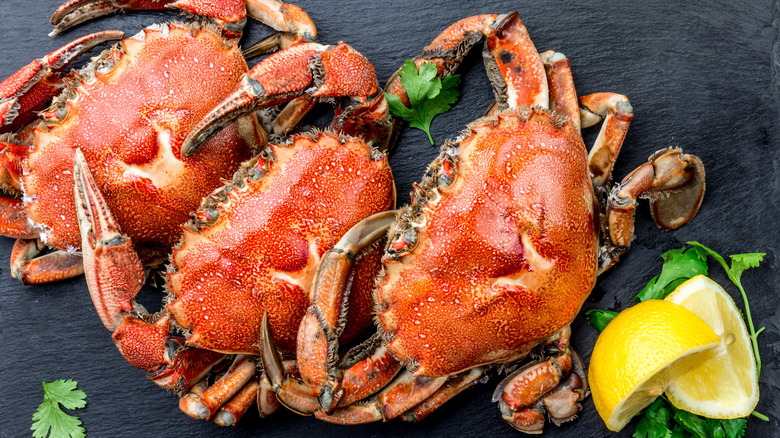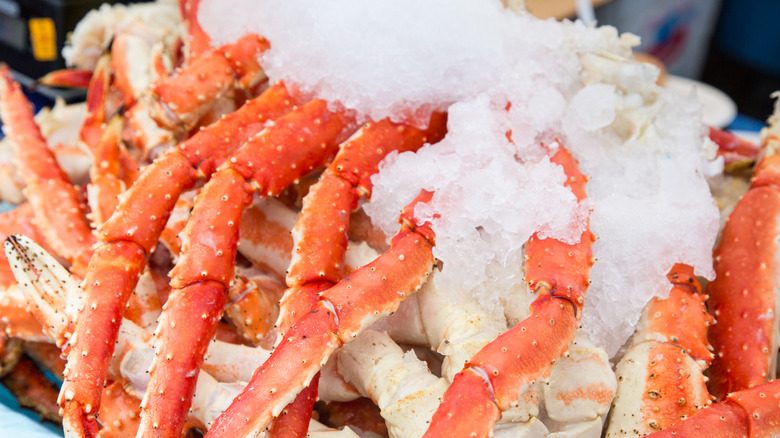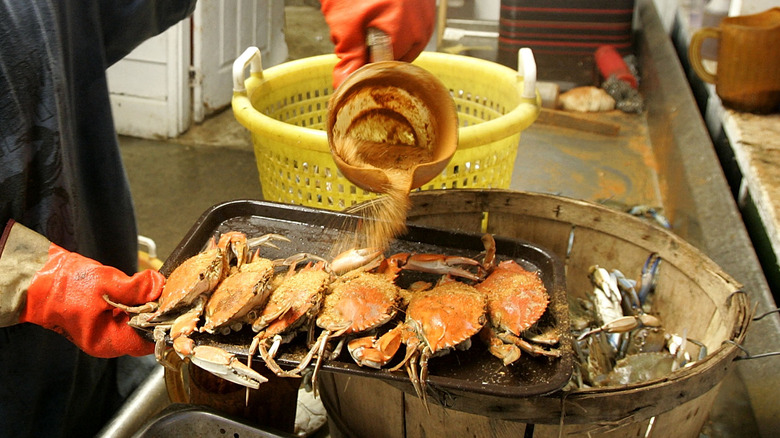Mistakes Everyone Makes When Cooking Crab
Whether you've been serving up crab from your home kitchen for decades or are a newbie, there are a lot of mistakes you can make when cooking this crustacean. When you've gone to the trouble and expense of preparing crab to eat, the last thing you want is to end up with a disappointing meal. Some of these mistakes might result in less-than-stellar flavor and texture with your shellfish, while others relate to safety.
Dodging these errors starts right at the beginning when you're at the fish market or grocery store. Thus, we spoke with Caitlin Carney, co-owner of Porgy's Seafood Market in New Orleans, who gave us some great tips for buying and storing crabs. The cooking process is also fraught with possible pitfalls, so we've included information to help you avoid some common missteps in the kitchen. Once you correct the mistakes you've been making with crab, you will be turning out dishes more like a pro — like this Cajun Crab Boil — and enjoying them more, too.
Not knowing which variety to buy
Although there are over 10,000 crab species in the world, you don't have to know about every type. Caitlin Carney, co-owner of Porgy's Seafood Market in New Orleans, says, "The best crabs to buy are the ones that are from closest to where you live. We only source blue crabs for that reason." Thus, it's important to know what types of crabs live in the waters nearest your home. Anything else you find won't be as fresh.
Knowing about the more common varieties can help you make the best choice. King crabs and snow crabs provide the most meat because they are larger. Molted blue crabs are what you want for recipes calling for soft-shell crabs. If you like sweet crab meat, stone crabs and Dungeness crabs are good choices. Snow crabs taste sweet and somewhat salty, while blue crabs are sweet and buttery or nutty. Meanwhile, king crab has a richer flavor. If texture matters, stone crabs and blue crabs are known for being flaky. Both blue crabs and Maryland crabs are tender and delicate. While Dungeness crab is also tender, its leg and body meat is both more meaty and hearty.
If you can't buy fresh, frozen crab meat is the next best option when the flavor and texture are important. However, if you're making a recipe that involves mixing crab in with other ingredients, canned crab meat can work.
Not cooking with live crabs
"To spot good quality crabs, first and foremost, they have to be alive," Porgy's Seafood Market co-owner Caitlin Carney says. "That's No. 1!" If crabs are not alive, they should be precooked before you buy them. If not, absolutely do not use them. If you can't find live crabs at your local supermarket, you should try an Asian market or Costco. You can even have live crabs shipped to you.
Once crabs die, they start decomposing and become too riddled with bacteria or toxins to eat safely. On rare occasions consuming spoiled crabs can be fatal. Thus, eating a crab that didn't die immediately before cooking can put your health at risk. While crabs stored below room temperature go into a state of torpor and may not move, they could be dead if they have a fishy or ammonia-like odor, their eyes don't move when touched, they have dull eyes, or their back legs hang limp when you pull them.
If you're a newbie at handling shellfish, It is possible to cook live crabs more humanely. You can place them in an ice water bath or in a freezer for a few minutes to put them to sleep (torpor) before boiling them. There's also a tool called a Crustastun that can stun them with an electric shock. Others euthanize them with an icepick to the head or through the middle of the underside of their body to destroy the nerve center immediately before boiling.
Not knowing how to spot the best crab while shopping
It can be challenging to know which crab to pick while shopping. Color, gender, look, texture, and smell can all be important.
The color of a crab can tell you a lot about how much meat it has. Porgy's Seafood Market co-owner Caitlin Carney explains, "[W]hen a crab has a dark rusty bottom, it indicates that they have more meat. If they are very light, or white, in color, it means that they have recently shed and therefore will not have a lot of meat." Carney also says it's "important to think about the gender of the crabs. Female crabs have roe sacks, male crabs do not." You can tell the gender by examining the abdomen. The female's abdomen is dark, wide, and looks like a round bee hive. The male's abdomen is light, narrow, and looks like a pyramid. The male tends to weigh more, and some people think the meat has a different texture and taste. Male crab meat also tends to be flakier, while female crab meat can be more dense and may be slightly sweeter.
While buying live crab is ideal, buying pre-cooked crab is another option. There are a few things you should look for to ensure they're not spoiled. Pre-cooked crab should smell like the ocean and not smell fishy or like ammonia. The meat shouldn't be sticky, mushy, mealy, milky-looking, grey, or blue either. All of these qualities are signs of spoilage.
Using the wrong type of pre-cooked meat for your recipe
If you decide to buy canned or jarred crab, there are several grades of meat from which to choose. Ultimately, you'll want one with the right taste and texture for your recipe. Keep in mind, though, that there's no standard for texture or size among the grades, so what you see may vary somewhat from brand to brand. Be sure to check the description on the container.
Most precooked crab meat is white meat. If you want large pieces of crab meat, you'll want to choose jumbo lump crab meat. These pieces are from the back of the crab's body, with each crab contributing two large chicken-nugget-sized chunks. Lump crab meat comes in smaller pieces than jumbo lump crab meat. The texture is more like shreds than chunks, so lump meat works well when mixing it with other ingredients. There's another grade called special, which comes from inside the crab's body shell. It's smaller pieces of shredded meat that work well when you need the meat to still look nice, like with crab-stuffed mushrooms. Backfin grade combines jumbo lump crab meat and special crab meat to give you a mix of textures.
Claw meat is the only dark meat crab, and like the dark meat on chicken, it has a more robust flavor. It often comes with larger oblong and smaller shreds. When the flavor of crab is important, you'll want to look for claw meat.
Not knowing how to store live crabs before you're ready to cook them
If you bring crabs home alive and let them die before you get around to cooking them, you've wasted your money since they'll be unsafe to eat. So, it's essential to know what to bring with you to the seafood market and how to keep them alive until you're ready to cook.
Porgy's Seafood Market co-owner Caitlin Carney says, "To store live crabs, you want to keep them live, moist but not in pooled water. We recommend taking an ice chest, opening its spill valve and leaning it on an angle so it can drain. Put the crabs in there and cover with a cool damp burlap and thick towel." Keeping the spill valve open with the lid closed will also help them breathe without chancing their escape. While crabs need to stay cool, anything below 50 degrees Fahrenheit can kill them. Standing water can also kill them, so gel packs at the bottom of the cooler are safer than ice for keeping them cool. If ice is your only option, enclose it in something that won't leak.
Without the right environment and food, crabs will stay alive only for about 24 hours, so it's a good idea to plan to eat them the day you buy them. They just need to stay cool and not dry out.
Not knowing how to clean crabs for flavor and safety
Knowing how to clean crabs is important both to ensure a tastier end product and to avoid getting sick. After you've cooked your crab, it's important to remove the organs. A study in Heliyon indicates that trace metals may accumulate more in crabs' gills and digestive glands than in other edible body parts. Plus, these organs can taste bitter.
You'll want to be especially careful to remove the crabs' lungs or gills, which look edible but aren't. These triangle-shaped organs are located under the body shell on each side of the crab and are slightly feathery-looking.
One thing to note is that, if you rinse your cooked crab during the cleaning process, you're also rinsing away some of the flavor. A lot of people collect the yellow and sometimes greenish substance called "mustard" and other liquids from the crab's body to use in stocks and sauces. However, it's important to be aware that this mustard is the crab's hepatopancreas, which can harbor toxins. For safety reasons, it's best to avoid that part.
Not knowing how to prepare a soft-shell crab for cooking
After crabs molt and leave their hard shells behind, they become soft-shell crabs. Their prep process is different than with hard-shelled crabs. Cleaning begins before cooking since you can simply lift the top of the shell to expose the innards.
Since the lungs can harbor pathogens and don't taste so great, you'll want to remove them. Some people also remove the hepatopancreas (the mustard) for safety reasons. Luckily. It's easy to use scissors to snip them away and still keep the shell intact. You also will probably want to cut off the facial features like the crab's eyes and mouth since they can harbor grit. Another mistake you may be making when cooking soft-shell crab is not using your scissors to pop the bubbles located behind the face. Not popping them during prep can result in them releasing liquid during cooking. You'll also want to snip off the hard apron from the underside of the crab so that you have a finished product that's all edible.
If you've purchased a soft-shell crab, avoid boiling it. The shell is so delicate that it will fall apart in boiling water. Instead, most recipes serve soft-shell crabs deep-fried, pan-fried, or baked.
Boiling crab too long
After going to all the trouble to buy fresh crabs and keep them alive, it can be incredibly disappointing if you cook them too long. Instead of succulent or flaky, the meat will be rubbery and tough. While you can always put crab back in to cook longer if it's undercooked, you can never salvage overcooked crab.
When boiling hard-shell crabs, there are a few signs that indicate they are done. First of all, they will turn bright orange or red since heat destroys the blue crustacyanin protein in their shells and releases orangish-red astaxanthin. The longer the crab stays in the boiling water, the brighter the shell color. A crab restaurant in Baltimore, Maryland, called Costas Inn explains on its website, "Once they float, they are almost done. Another two or three minutes should suffice before you turn the burner off."
It can help to follow a recipe using your specific type of crab when determining a boiling time since crabs come in different sizes. Also keep in mind that if you add cold crab to boiling water, the boiling is going to stop because of the temperature change. So, if your recipe gives you a boiling time, wait a few minutes to get the water back up to boiling again before you start your timer. When done cooking your crabs, you will want to place them in cold water for five to 10 minutes to stop any carryover cooking that might occur.
Not steaming your crabs upside down
Steaming is another common way to cook fresh crab. If you haven't been steaming your crabs upside down, you've been doing it wrong all your life. Sure, you can steam crabs right side up, but they won't be nearly as tasty as they will be when cooked upside down.
Some people posting on the Blue Crab Forum who had been steaming their crabs right-side-up for decades ended up amazed at how much better crabs taste when they're flipped upside down to cook. Crab lover @bgfishhook1 said, "This up side down method is without a doubt the only way that I will steam them again. I do not know what it does but the crab meat is tender, sweet, and moist and there is a better taste to them for some reason." If you're not planning to eat all the steamed crabs right away, you'll probably want to store them in the fridge upside down, too.
Beyond producing crab that tastes better, has a better flavor, and has more moisture, people who have tried it report other advantages to steaming crabs upside down. For one, it can help solve the problem of meat sticking to the inside of the shell — even the claws.
Letting crabs get too dry while baking them
If your recipe calls for baking a crab, it typically gets parboiled first or has been cooked and frozen before you bought it, like crab legs. But there's still plenty of room for mistakes. Letting your crabs dry out in the oven can be disappointing. However, there are some tricks you can use to keep your crab nice and moist, even inside a dry oven. Interestingly, they all involve foil and steam.
One method that the Alaskan King Crab Company suggests for crab legs is to create a steamy environment. The company says once you've added the crab and preferred flavorings, "pour about 1/8 inch of hot water into the bottom of the pan, then cover the entire dish tightly with aluminum foil. Don't forget to cover — this step is going to help create a steam that will keep the crab legs from drying out!"
Another way to use foil to help trap steam while baking crabs is to put them in foil packets. If you butter up the crabs before placing them in the packets, all the liquid in the butter can help create a sauna effect as they bake.
Not cooking crab long enough
Undercooking crab is a mistake you should never make because it has the potential to make you extremely sick, damage organs, or even cause death. So, it's essential to cook it well. Some of the risks associated with undercooked crabs include exposure to neurotoxins, bacteria, and parasites.
Some of the illnesses you can contract from eating undercooked crab are pretty nasty. If you get a Paragonimus parasite from eating undercooked crab, it can infect your lungs and even spread to your brain. It may also possibly cause intestinal problems, flu-like symptoms, meningitis-like symptoms, and in rare cases death. There are several types of Vibrio bacteria that infect crabs and can cause intestinal distress when eaten. For people with pre-existing medical conditions or compromised immune systems, this bacteria can be fatal if not treated. You can even pick up bacteria like E. coli or Salmonella from crabs, both of which cause intestinal problems and sometimes death.
Luckily, the texture and color of your crab will let you know when it's done. If you've cooked crab enough, the shell will turn from its original color to an orangish red color. Plus, the meat will be flaky when done.
Cooking crab meat while it's still frozen
It can be a big mistake to cook frozen crab meat, especially if you have meat with different thicknesses. If you start off cooking from frozen, the thicker pieces might need to cook longer than the thinner pieces to get done. Another problem with cooking crab meat from frozen is that it can result in a finished product with less moisture.
Alaskan King Crab Company, which ships frozen king crab legs to customers all the time, has this advice: "No matter how you're cooking your crab, the first step is to thaw the crab legs 8-12 hours overnight in the refrigerator. Once they've thawed, you can keep your king crab legs in the refrigerator for up to 5-7 days."
If you need to thaw your frozen crab more quickly, you can use cold water. You'll just submerge it in cold water with water changes every 30 minutes.
Using the wrong seasoning or seasoning method
One mistake you don't want to make is messing up the seasoning of your crabs. J.O. Spice explains that there are different types of crab seasonings. "If it's too salty you are using the wrong blend!" (via Facebook). Be sure to check the salt content of your seasoning because the type people use in the water when steaming and boiling crabs is often way saltier than the type that's appropriate to season crab after you've cooked it.
How much seasoning you use depends on your cooking method as well as personal preference. While some people use just two tablespoons of seasoning per gallon of water when steaming or boiling, others go as far as to add an entire box (12 tablespoons) of Old Bay seasoning to their pot of water. Since the seasoning dilutes in the water, it's fine. Even if you prefer to season your crab after it's cooked, adding seasoning to the boiling water helps flavor the crab.
With baking or grilling, you can add the seasoning before or after cooking. However, you need to be mindful of how much salt is in the seasoning lest you add too much or add salt when you're already using a salty seasoning.
